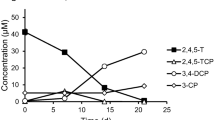Summary
The requirements and conditions for pentachlorophenol (PCP) biodegradation by a mixed bacterial culture was studied. The effects of oxygen, nutrients, additional carbon sources, pH and temperature are described. Up to 90% of PCP was degraded into CO2 and inorganic chloride in 1 week at an input concentration of <600 μM. Degradation continued when pO2 was lowered to 0.0002 atm but ceased when pO2 was further decreased to 0.00002 atm. Supplementary carbon sources, such as phenol, hydroxybenzoic acids or complex nutrients did not affect the biodegradation, but the presence of ammonium salts enhanced the rate of PCP degradation without affecting the yield of CO2. The degrading organisms were shown to be procaryotic mesophiles; no degradation was shown at temperatures below +8° and above +50°C. The optimum pH for degradation was from 6.4 to 7.2 and at higher pH value (8.4) degradation was inhibited more than at lower pH (5.6).
Similar content being viewed by others
References
Apajalahti JHA, Salkinoja-Salonen MS (1984) Absorption of pentachlorophenol (PCP) by bark chips and its role in microbial PCP degradation. Microb Ecol 10 (in press)
Chu JP, Kirsch EJ (1972) Metabolism of pentachlorophenol by an axenic bacterial culture. Appl Microbiol 23:1033–1035
Cirelli DP (1978) Patterns of pentachlorophenol usage in the United States of America — an overview. In: Ranga RK (ed) Environmental Science Research, vol 12. Pentachlorophenol: Chemistry, pharmacology and environmental toxicology. Plenum Press, New York, pp 13–18
Dickson D (1980) PCP dioxins found to pose health risks. Nature (London) 283:418
Edgehill RU (1982) Microbial treatment of water and soil to remove pentachlorophenol. PhD Thesis. Cornell University
Edgehill RU, Finn RK (1983) Microbial treatment of soil to remove pentachlorophenol. Appl Environ Microbiol 45:1122–1125
Fogel S, Lancione RL, Sewall AE (1982) Enhanged biodegradation of methoxychlor in soil under sequential environmental conditions. Appl Environ Microbiol 44:113–120
Guthrie MA, Kirsch EJ, Wukasch RF, Grady CPL (1984) Pentachlorophenol biodegradation II. Anaerobic. Water Res 18:451–461
Hakulinen R, Salkinoja-Salonen M, Saxelin M-L (1981) Purification of kraft bleach effluent by an anaerobic fluidized bed reactor and aerobic trickling filter at semitechnical scale (Enso-Fenox). Proc. Techn. Ass. Pulp Paper Ind., 1981 Envir. Conf. TAPPI Press, Atlanta GA, pp 197–203
Jagnow G, Haider K, Ellward PC (1977) Anaerobic dechlorination and degradation of hexachlorocyclohexane isomers by anaerobic and facultative anaerobic bacteria. Arch Microbiol 115:285–292
Kirsch EJ, Etzel JE (1973) Microbial decomposition of pentachlorophenol. Journal Water Pollution Control Federation 45:359–364
Lu PY, Metcalfe RL, Cole LK (1978) The environmental fate of 14C-pentachlorophenol in laboratory model ecosystem. In: Range RK (ed) Environmental Science Research, vol 12. Pentachlorophenol: Chemistry, pharmacology and environmental toxicology. Plenum Press, New York, pp 53–63
Moos LP, Kirsch EJ, Wukasch RF, Grady CPL (1983) Pentachlorophenol biodegradation I. Aerobic. Water Res 17:1575–1584
Murthy NBK, Kaufman DD, Fries GF (1979) Degradation of pentachlorophenol (PCP) in aerobic and anaerobic soil. Environ Sci Health B 14:1–14
Nurmiaho-Lassila EL, Haahtela K, Sundman V (1981) A new spiral structure associated with the flagellum of Azospirillum lipoferum. Can J Microbiol 27:1267–1271
Paasivirta J, Särkkä J, Leskijärvi T, Roos A (1980) Transportation and enrichment of chlorinated phenolic compounds in different aquatic food chains. Chemosphere 9:441–456
Pfaender FK, Alexander M (1972) Extensive microbial degradation of DDT in vitro and DDT metabolism by natural communities. J Agric Food Chem 20:842–846
Pierce RH, Victor DM (1978) The fate of pentachlorophenol in an aquatic ecosystem. In: Ranga RK (ed) Environmental Science Research, vol 12. Pentachlorophenol: Chemistry, pharmacology and environmental toxicology. Plenum Press, New York, pp 41–52
Renberg L, Marell E, Sundström G, Adolfsson-Erici M (1983) Levels of chlorophenols in natural waters and fish after an accidental discharge of a wood-impregnating solution. Ambio 12:121–123
Salkinoja-Salonen M, Saxelin M-L, Pere J, Jaakkola T, Saarikoski J, Hakulinen R, Koistinen O (1981) Analysis of toxicity and biodegradability of organochlorine compounds released into the environment in bleaching effluents of kraft pulping. In: Keith LH (ed) Advances in the identification and analysis of organic pollutants in water, vol 2. Ann Arbor, MI, pp 1131–1164
Salkinoja-Salonen M, Apajalahti J (1982) Studies on microbial degradation of pentachlorophenol and 2,3,7,8-tetrachlorodibenzo-p-dioxin. US Environmental Protection Agency, IERL Report on project no 68-03-2936, Cincinnati, Ohio
Salkinoja-Salonen M, Hakulinen R, Valo R, Apajalahti J (1983) Biodegradation of recalcitrant organochlorine compounds in fixed film reactor. Wat Sci Tech 15:309–319
Salkinoja-Salonen M, Valo R, Apajalahti J, Hakulinen R, Silakoski L, Jaakkola T (1984) Biodegradation of Chlorophenolic Compounds in Wastes from Wood-Processing Industry. In: Klug MJ, Reddy CA (eds) Current perspectives in microbial ecology. American Society for Microbiology, Washington DC, pp 668–676
Standard methods for the examination of water and wastewater, 14th ed. (1976). American Public Health Association, New York
Suzuki T (1977) Metabolism of pentachlorophenol by a soil microbe. J Environ Sci Health B 12:113–127
Valo R, Kitunen V, Salkinoja-Salonen M, Räisänen S (1984) Chlorinated phenols as contaminants of soil and water in the vicinity of two finnish sawmills. Chemosphere 13:835–844
Watanabe I (1973) Isolation of pentachlorophenol decomposing bacteria from soil. Soil Sci Plant Nutr 19:109–116
Watanabe I (1977) Pentachlorophenol decomposing and PCP tolerant bacteria in field soil treated with PCP. Soil Biol Biochem 9:99–103
Wong ASH (1979) Fate of pentachlorophenol in the aquatic environment. PhD Thesis. University of California, Davis
Author information
Authors and Affiliations
Rights and permissions
About this article
Cite this article
Valo, R., Apajalahti, J. & Salkinoja-Salonen, M. Studies on the physiology of microbial degradation of pentachlorophenol. Appl Microbiol Biotechnol 21, 313–319 (1985). https://doi.org/10.1007/BF00252710
Received:
Issue Date:
DOI: https://doi.org/10.1007/BF00252710




